|
|
|
|
|
|
| On this page, I have some pictures of some
carbon fiber being made. I wanted the stiffest and strongest thing
possible. I had to do a ton of research on the web. I even found myself at
places like the NASA site looking at how to increase the modulous of a structure. Tons of reading but I finally got the insight that I needed.
I went through a ton of math sites, and structural sites too trying to
come up with the correct fiber orientation and shape of the structure.
After going through a lot of info, I finally came to the conclusion that
if I made this using this type of fiber, it would be ridiculously stiff
and total overkill. Perfect! Sign me up. As it turned out, I found some really cool solutions that let the Diablos do things that were previously not possible. I've been able to do some strategic reinforcement that allows me to totally eliminate any chance of a dead spot anywhere on the neck. The entire neck is so alive. It also allows the necks to do some other things too. No need for a huge amount of wood at the heel either. Why, no need for a heel at all. This process is especially good for someone who is touring and is going from one climate to another. The neck is not concerned with climatic changes. Oh, and the tone that the stiffness makes!!!!!!! This was a monumental job. It looks easy here but it was in no way fun, easy, or inexpensive. Quite the extreme opposite. But, again, the results were worth it. |
| Here, the form has been cut. It went to visit Slacker (my big machine) and was milled to make the base which will provide the shape of the carbon fiber pieces. |
 |
|
| Here we see our specimen in its embryonic state. This is the release fabric on the form. Without this, the carbon fiber would become part of the form and would never come off. Don't want that to happen! |
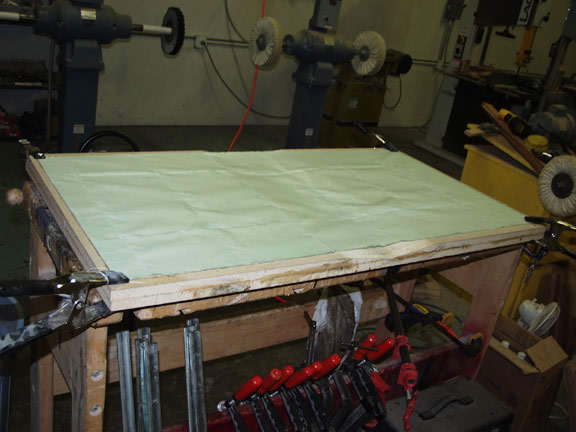 |
|
| This is the special carbon fiber. The type and weave of the fiber is crucial to its performance. Using this specific fiber will make the stiffest part possible. This is 16 yards. You buy it by the yard and Man! It's not cheap!!!!!! |
 |
|
| Now we see that our friend, carbonius fibernorum, is now saturated with epoxy. Since I was the only one here, there was no one around to take pictures of it being saturated. This is one nasty job! It uses a ton of epoxy too. Every single tiny fiber has to be saturated. That is a hard thing to do. It took a long time to get it done. |
 |
|
| Now, we see that our friend is ready to have the breather/release fabric on it. This will let the excess resin be sucked out into the batting. You don't want excess resin in the fibers. |
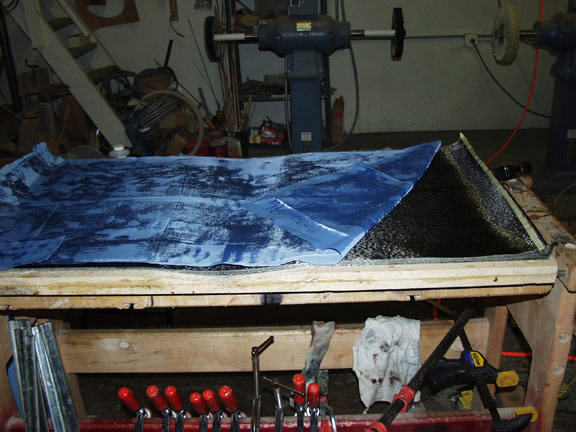 |
|
| You can see that some of the excess resin is all ready coming through the fabric. That is good. |
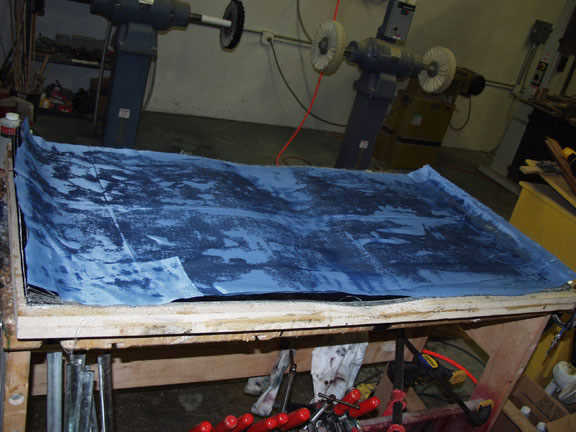 |
|
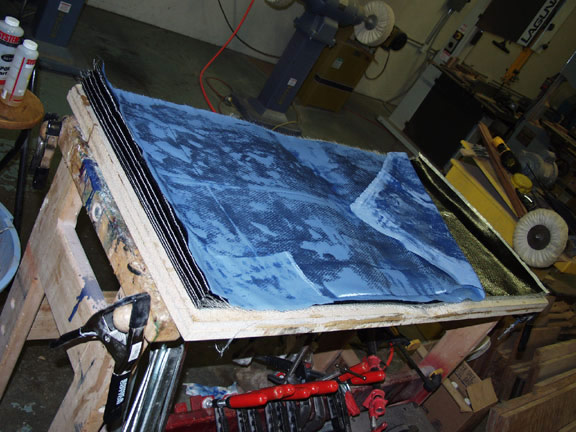 |
||
| This is the absorbent batting . The excess resin is drawn up into this when the vacuum starts. |
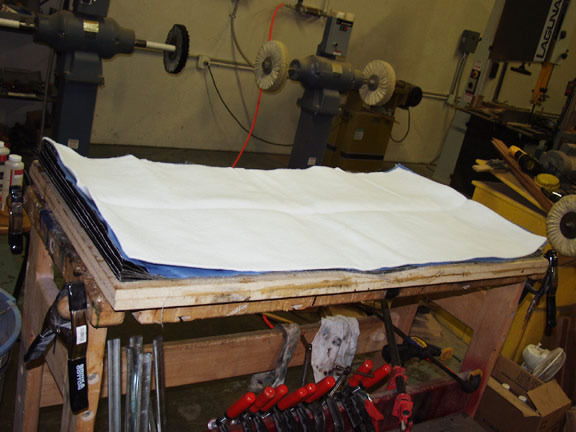 |
|
| Drum roll please..... Alas, the mighty vacuum! This is pulling a tremendous vacuum level. I had to get a very expensive vacuum pump to do all of the stuff that I wanted it to do. I found this great LeBold pump. It's a very industrial Scientific pump. It pulls an astronomical vacuum level! I use it to hold the parts in Slacker also. It holds the parts being cut to the fixtures. I made a lot of fixtures and they are all incredibly precise and use vacuum. The vacuum is great for making all kinds of carbon fiber stuff, holding parts, and gluing things like tops on guitars. This has about 16,128 pounds of force pressing down on it . |
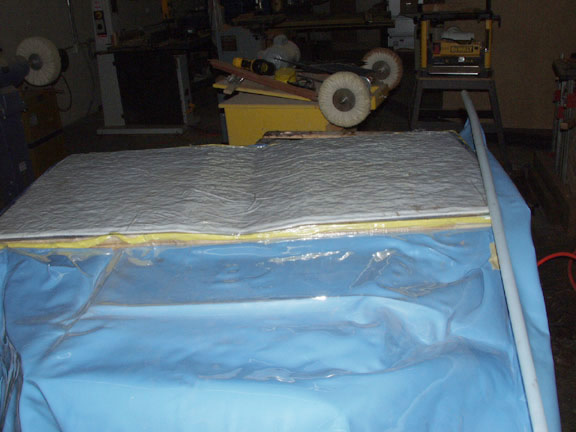 |
|
| Here we see the whole sheet in
Slacker. It is over 4 X 2 feet. Actually, it's a little bigger than that so that
the edges can be cut off and thrown away.
Slacker didn't like this much. Well, actually the tools didn't like it much. Not at all! I tried cutting it with solid carbide. It ate that up. I then had a diamond tooling rep come by. I nearly flipped when he told me how much the tooling would be! So, the little hamsters in my head started turning...... A short trip to Home Depot and I found an abrasive wheel that would cut it. The only problem with this solution is that I had to bundle up in two long sleeve shirts and wrap up all exposed skin. That and wear a respirator while cutting it. The tiny particles are pure carbon fiber and they are extremely light. They hang in the air for a few hours. If you think fiberglass on you skin is bad, you couldn't imagine this! I think that it would be a good torture technique for use against terrorists. They would think twice if they even thought that this was in store for them if they're caught. |
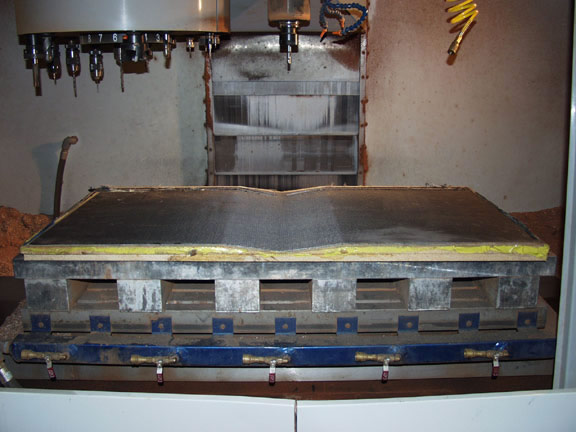 |
|
| This is the sheet after Slacker had a
try and before my discovery of the abrasive wheel. You are looking at a picture of the strongest plate you are likely to ever encounter. You could never bend that sheet. Even the possible Governator of California would pale next to this thing. |
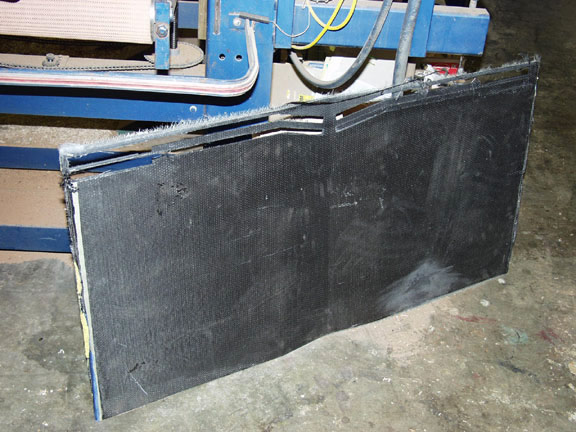 |
|

|